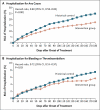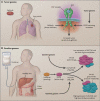Genomics and drug response
- PMID: 21428770
- PMCID: PMC3184612
- DOI: 10.1056/NEJMra1010600
Genomics and drug response
Figures



References
-
- Weinshilboum RM, Wang L. Pharmacogenetics and pharmacogenomics: development, science, and translation. Annu Rev Genomics Hum Genet. 2006;7:223–45. - PubMed
-
- Manolio TA. Genomewide association studies and assessment of the risk of disease. N Engl J Med. 2010;363:166–76. - PubMed
-
- Weinshilboum R. Inheritance and drug response. N Engl J Med. 2003;348:529–37. - PubMed
-
- Evans WE, McLeod HL. Pharmacogenomics — drug disposition, drug targets, and side effects. N Engl J Med. 2003;348:538–49. - PubMed
Publication types
MeSH terms
Substances
Grants and funding
- U19 GM061388/GM/NIGMS NIH HHS/United States
- U01 GM063340/GM/NIGMS NIH HHS/United States
- U01-HG005137/HG/NHGRI NIH HHS/United States
- R01 GM028157/GM/NIGMS NIH HHS/United States
- K22-CA130828/CA/NCI NIH HHS/United States
- U01-GM63340/GM/NIGMS NIH HHS/United States
- U01 HG005137/HG/NHGRI NIH HHS/United States
- U19-GM61388/GM/NIGMS NIH HHS/United States
- R01-CA138461/CA/NCI NIH HHS/United States
- R01-CA132780/CA/NCI NIH HHS/United States
- R01-GM28157/GM/NIGMS NIH HHS/United States
- R01 CA132780/CA/NCI NIH HHS/United States
- K22 CA130828/CA/NCI NIH HHS/United States
- R01 CA138461/CA/NCI NIH HHS/United States
- UL1RR025747/RR/NCRR NIH HHS/United States
- UL1 RR025747/RR/NCRR NIH HHS/United States
LinkOut - more resources
Full Text Sources
Other Literature Sources
Medical
